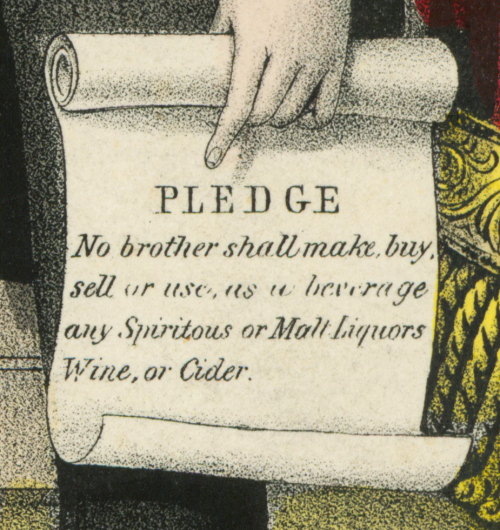This is the next installment in our continuing series, “Did Prohibition Prohibit Cider?”
____________________________________________________
Though Temperance originally advocated moderation, after the 1830s it fought for total abstinence (from alcohol consumption, that is). As Temperance changed, cider went from being a temperance drink, to a contributing cause, and finally to being the cause of alcohol abuse in America.
Temperance grew more potent because Americans at the beginning of the nineteenth century were a drunken, hot mess. Prior to the Revolutionary War Americans generally drank in a couple of ways – daily dram drinking (small tipples throughout the day, not with the intention to get drunk) and occasional social binging (essentially inebriation parties). The Revolution unleashed a degree of freedom completely unknown before, and with it came excessive drinking. Some people were anxious and uncertain about this new-found freedom and sought refuge in alcohol, while others saw drinking to intoxication (whether alone or not) as an expression of personal liberty. Whether it was from anxiety or freedom, studies suggest that more alcohol was consumed per person between 1790 and 1830 then at any other time in American history. (1)
As we saw last time, Cider was originally tolerated as a Temperance drink. Temperance advocates focused on hard liquor instead. Up through the 1820s if Temperancers viewed cider as a problem it was because it could be distilled into apple brandy. Some Temperance-supporting farmers worried that their apple orchards were the root of this evil. (2) For example, one “farmer” entitled his 1827 op-ed, “What Shall I Do With My Apples?” and continued
Is the question now rising in the mind of many a farmer, who is, or would appear, the friend of temperance. If he gathers his apples, of course he must make them into cider; and if he makes them into cider, of course he must sell it; and if he is to sell it, of course he must sell it to the distiller, or procure it distilled and then sell the brandy; and if the brandy is sold, it must be drank; and in this way every barrel will make and circulate liquid fire enough to ruin a soul, if not to destroy a life.
In 1829, a Connecticut farmer was quoted as saying he worried about having an orchard, “because the apples may be ground into cider, the cider may be distilled into spirituous liquor, and liquor, if drunken, will make a man drunk.” (3)
In the 1820s, Temperance organizations were established and spread across the nation. By the 1830s, these organizations hardened their view of softer alcoholic drinks. In 1869 one Temperance supporter explained this change, saying
In the infancy of the temperance reform, say from 1826 to 1832, a pledge, including spirituous or distilled liquors, was the only pledge in force, so that a man could be an active member of a temperance society and yet use and dispense in his household, wine, beer, or cider. A few years of experience convinced the earnest friends of temperance, that these drinks were constantly manufacturing new drunkards, and were also carrying back to their cups the most of those over whose reformation they had rejoiced. Hence the adoption of the total abstinence pledge, embracing the fermented as well as the distilled liquors.

Artistic rendering of a Temperance pledge. Detail from the Sons of Temperance, c. 1845. Wikimedia.
From then on the Temperance view was that cider, not apple brandy, made drunkards. In 1836 the American Temperance Society said that, “Cider, strong beer, and wine are… the foundation of intemperate drinking.” Physician Samuel Bayard Woodward wrote in 1838 that, “Even cider, although in many instances it may be taken without danger, will induce, in many others, a love of something stronger, and, as the natural tendency is to desire an increase of strength, it will increase the danger of a relapse.” In 1839 the American Temperance Union wrote that, “Wine and cider are great and mighty hindrances to the overthrow of intemperance.”
The 1838 Temperance Map illustrated these views.
The map shows the Lands of Inebriation and Self-Denial. The map is an allegory of one’s descent into drunkenness and the (one and only?) route to salvation. The Ocean of Animal Appetites leads you to Inebriation. Inebriation consists of the territories of Indulgence, False Security, False Pleasure, False Comfort, False Hope, Total Indifference, and Ruin. The entry into the “Land of Inebriation” – a horrible place full of nasty pleasures and self-inflicted pains – was “Cider Inlet.”

Detail from upper left of the map.
From the 1830s onward, cider was portrayed as the “gateway” drink to harder stuff. During that time, Temperance worked to prevent alcohol addiction by working to prevent cider consumption.
Next Time: Did intemperate Temperance cut down orchards?
************************************
1. See W.J. Rorabaugh, The Alcoholic Republic: An American Tradition. New York: Oxford University Press, 1979), Chapters 2 and 5.
2. It is often difficult to tell if a temperance article was authored by a farmer or by a Temperancer posing as a farmer to use “peer” pressure.
3. Weekly Eastern Argus, published as Eastern Argus. (Portland, Maine) • 07-14-1829, Page 3.



